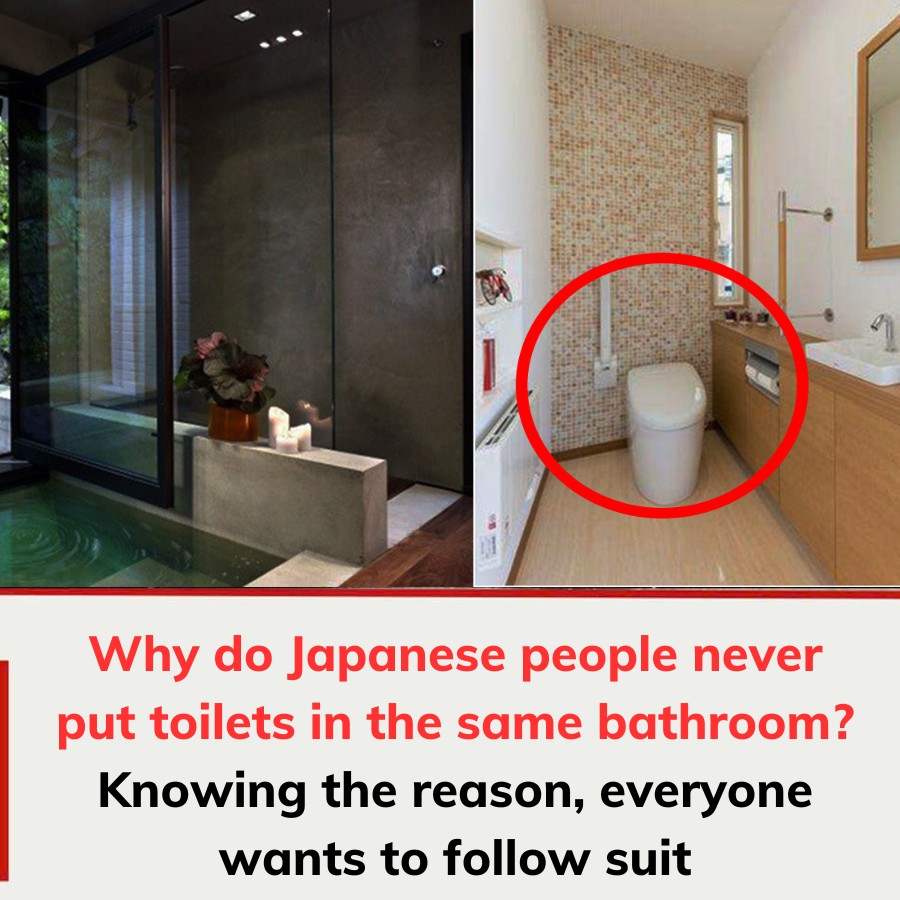In Japan, the separation of toilets and bathrooms is a long-standing practice deeply rooted in cultural tradition, hygiene principles, and practical design considerations. While many Western homes combine the toilet and bathing areas into one room, Japanese homes intentionally keep these spaces apart. This design choice isn’t arbitrary—it’s a thoughtful approach aimed at maintaining cleanliness, promoting health, and enhancing everyday convenience.

The first reason behind this separation stems from Japanese cultural values, particularly the emphasis on cleanliness. Historically, toilets were considered impure spaces, often built far from the main living areas to prevent odors and bacteria from permeating the home. Even in modern homes, toilet spaces are carefully designed with ventilation and natural light to maintain a fresh and airy atmosphere. This commitment to cleanliness isn’t just about appearance—it reflects a deeper cultural philosophy of respecting one’s living space and ensuring it remains pure.
The second reason relates to health and hygiene. In Japan, the bathroom is viewed as more than just a place for personal hygiene—it’s considered a sanctuary. It’s a space for relaxation, physical recovery, and rejuvenation. Many Japanese bathrooms feature deep soaking tubs, warm lighting, and a serene atmosphere meant to promote well-being. In contrast, the toilet serves a purely functional purpose and is associated with waste and bacteria. Combining these two spaces would risk contaminating the bathroom environment, undermining its purpose as a clean, peaceful retreat.
Scientific research supports this reasoning. Studies have shown that flushing a toilet can release bacteria into the air, with particles capable of traveling up to six feet. These airborne germs can settle on towels, toothbrushes, makeup products, and other personal care items. In fact, studies have found human fecal bacteria on toothbrushes stored in bathrooms with combined toilet spaces. By keeping these areas separate, Japanese homes minimize the risk of cross-contamination, protecting household health.
@muffintoppu Reply to @awrith_i_ate_ur_hamster hi i just woke up but im very passionate about japanese toilets #japaneseculture #japantok #nihongo #animefan ♬ original sound – Muffintoppu
Convenience also plays a significant role in this design choice. Japanese families value efficiency and harmony in their homes, especially in shared spaces. By keeping the toilet and bathroom separate, family members can use these facilities simultaneously without interrupting each other. One person can enjoy a peaceful soak in the tub or brush their teeth while another uses the toilet in privacy. This setup eliminates unnecessary conflict and streamlines daily routines.
Safety is another important factor. Modern Japanese toilets are incredibly advanced, equipped with features like heated seats, built-in bidets, automatic flushing, and even ambient sound effects for privacy. These high-tech toilets require electricity to function, making it crucial to keep the toilet area dry to avoid electrical hazards. By maintaining a dedicated, dry space for toilets, Japanese homes reduce the risk of accidents related to water exposure and electrical malfunctions.
The advantages of separating toilets and bathrooms become even more apparent when considering the risks associated with shared spaces. For example, toothbrushes and toothbrush holders are often breeding grounds for bacteria, including staphylococcus, mold, and yeast, particularly when stored near a toilet. Experts recommend replacing toothbrushes regularly and cleaning toothbrush holders at least twice a week to prevent bacterial buildup.
The bathtub, another essential part of the bathroom, is also a surprising hotspot for bacteria. While it may seem clean, the bathtub drain is one of the dirtiest spots in the home, with studies revealing up to 120,000 bacteria per square inch on drain covers. Additionally, the grout between bathtub tiles traps moisture and bacteria, making it another area that requires consistent cleaning.
Bathroom floors, though seemingly less concerning, still harbor bacteria. On average, bathroom floors contain about 764 bacteria per square inch. Regular cleaning and proper ventilation are necessary to keep these surfaces hygienic.
Bathroom surfaces, such as countertops and toilet lids, are equally vulnerable. With around 452 bacteria per square inch, these surfaces can quickly become contaminated. Anything placed on these surfaces, including makeup brushes, razors, or skincare products, is at risk of bacterial exposure. This is why applying makeup in a shared bathroom space is generally discouraged.
The bathroom sink, often overlooked, is another bacteria hotspot. While it’s a place for handwashing, it also collects water splashes, soap residue, and other contaminants, creating an ideal environment for germs. Research indicates that bathroom sinks can contain as many as 2,733 bacteria per square inch, emphasizing the importance of regular cleaning and disinfection.
Toilet paper and sanitary pads are particularly vulnerable in a humid bathroom environment. Bacteria spread by flushing can easily contaminate these items, posing a risk of gynecological infections for women. Storing these products in a dry, separate toilet space significantly reduces this risk.
In conclusion, the Japanese practice of keeping toilets and bathrooms separate isn’t just a cultural quirk—it’s a well-thought-out approach to maintaining cleanliness, promoting health, and improving convenience. By addressing issues of hygiene, preventing cross-contamination, and ensuring the safety of modern toilet technologies, this design choice reflects a balance of tradition, science, and practicality. It’s not just about aesthetics; it’s about creating a space where both functionality and peace coexist. For households considering this approach, the benefits are clear: cleaner spaces, healthier environments, and a more harmonious daily routine. Japan’s thoughtful approach to toilet and bathroom design serves as a valuable lesson in how small architectural choices can make a significant impact on health, safety, and overall quality of life.





